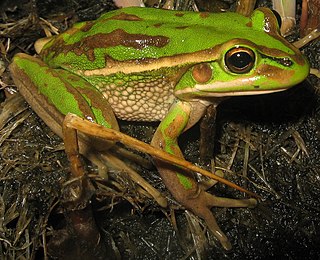Litoria spartacus is a species of frog in the subfamily Pelodryadinae of the family Hylidae. It is endemic to Papua New Guinea and is only known from two localities within the Kikori Integrate Conservation and Development Project Area in the Southern Highlands Province. It has affinities to Litoria macki and Litoria spinifera but has a smaller size and more extensively webbed hands and less tuberculate body.
Stegonotus is a genus of snakes in the family Colubridae. Species of the genus Stegonotus are native to Australia, Indonesia, and New Guinea.

Ranoidea is a genus of frogs in the subfamily Pelodryadinae. They are found in Australia, New Guinea, and two nearby groups of islands: the Maluku Islands, and the Louisiade Archipelago. The circumscription of this taxon is still controversial.

Ranoidea mira, also known as the chocolate frog, is a species of tree frog in the subfamily Pelodryadinae, and is part of the Ranoidea caerulea species complex. It was discovered in New Guinea by a research team led by Griffith University.
The parachuting frog, or pale-eyed parachuting tree frog, is a species of frog found in New Guinea. It is in the Nyctimystes gramineus complex with the Pinocchio frog and montane Pinocchio frog.
The montane Pinocchio frog is a species of frog in the subfamily Pelodryadinae. It is endemic to New Guinea. Scientists saw it on Hides Ridge in the karstic area of the Southern Fold Mountains in Papua New Guinea. Like the Pinocchio frog, it has a protuberance on its snout that can grow or shrink.
Mareku's tree frog is a species of frog in the family Hylidae. It is endemic to Indonesia. Scientists have seen it in the Wondiwoi Mountains in Papua Province.
Nyctimystes hunti is a species of tree frog in the subfamily Pelodryadinae. It is endemic to northern Papua New Guinea. Scientists have seen it only in Utai, Sanduan Province, but predict that also lives elsewhere on New Guinea.
Litoria christianbergmanni is a frog in the family Hylidae. It is endemic to Indonesia and has been found in the Fakfak Mountains at 860 meters above sea level.
Nyctimystes sauroni is a species of tree frog in the subfamily Pelodryadinae. It is endemic to Papua New Guinea. Scientists know it solely from the Kikori Integrate Conservation and Development Project area.
Litoria eurynastes is a frog in the subfamily Pelodryadinae, endemic to Papua New Guinea. It resembles Litoria bicolor, but it is larger.
Litoria viranula is a species of frog in the family Hylidae, endemic to New Guinea. It is in the same species group with Litoria bicolor.
Ranoidea robinsonae is a species of frog in the subfamily Pelodryadinae, endemic to Papua New Guinea.
Litoria richardsi is a species of frog in the family Hylidae, endemic to Papua New Guinea and Indonesia. Scientists have seen it about 80 m above sea level.
Litoria amnicola, the Raja Ampat torrent tree frog, is a frog in the family Hylidae, endemic to Indonesia. It has been found on Salawati Island, which is in the Raja Ampat archipelago.
Litoria haematogaster, also known as the red-bellied tree frog, is a species of frog in the subfamily Pelodryadinae. It was described in 2023 by Australian herpetologist Stephen Richards and his colleagues Stephen Donnellan and Paul Oliver. The specific epithet haematogaster comes from the Greek haema (‘blood’) and gaster (‘belly’), with reference to the frog's bright red abdomen.
Litoria daraiensis, also known as the Darai Plateau tree frog, is a species of frog in the subfamily Pelodryadinae. It was described in 2023 by Australian herpetologist Stephen Richards and his colleagues Stephen Donnellan and Paul Oliver. The specific epithet daraiensis refers to the type locality.
Litoria lisae, also known as Lisa's tree frog, is a species of frog in the subfamily Pelodryadinae. It was described in 2023 by Australian herpetologist Stephen Richards and his colleagues Stephen Donnellan and Paul Oliver. Both the common name and the specific epithet lisae refer to Stephen Richards' wife.
Litoria gracilis, also known as the slender spotted tree frog, is a species of frog in the subfamily Pelodryadinae. It was described in 2023 by Australian herpetologist Stephen Richards and his colleagues Stephen Donnellan and Paul Oliver.
Litoria naispela, also known as the Crater Mountain treehole frog, is a species of frog in the subfamily Pelodryadinae. It was described in 2023 by Australian herpetologist Stephen Richards and his colleagues Stephen Donnellan and Paul Oliver. The specific epithet naispela is a Tok Pisin term meaning ‘beautiful’ or ‘attractive’.

